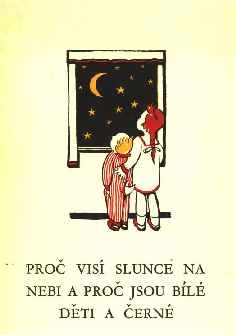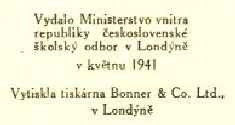|
UNDER CONSTRUCTION!!!
1. Ships involved in the
evacuation
2. Eyewitness account
from a civilian participant
3. The War at Sea - part
of the official history
4. Links to other web
sources about the ships
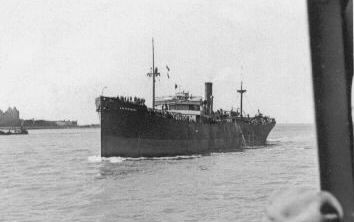
Image courtesy of John Schaffa. Unknown ship and port.
1. Ships involved in the
evacuation
The following table shows those ships involved in
the evacuation of Czechoslovak troops, along with the numbers of personnel they took on
board and from where. The source of information is an Admiralty file, compiled at at the
request of the Czechoslovak Government to ascertain which seamen should be awarded
Czechoslovak honours for their actions.
| Name
of ship and commanding officer/master |
To
Gibraltar from |
CzSk
Army+Airforce |
CzSk
Civilians |
H.M.S. VELOX
Commander James Chaignean Colvill R.N. (Retd.) |
Organised
embarkation at Port Vendres and Sete |
H.M.S.
KEPPEL
Lt.Com. Edward Gavin Heywood-Lonsdale R.N. |
Organised
the embarkation at Sete, on instructions from H.M.S. VELOX |
S.S. MAHOMET
ALI EL KEBIR (Egyptian)
John Pratt Thomson |
Sete |
1,200 |
100 |
S.S.
NORTHMOOR
Francis Gordon Nesbitt |
Sete |
1,350 |
213 |
S.S.
BRITANNIC
Herbert Henry Wilson |
Sete |
63 |
2 |
S.S. ROD EL
FARAG (Egyptian)
Thomas Richard Muckle |
Marseilles |
1,002 |
- |
S.S. APAPA
(Egyptian)
Edward Vaughan Davies |
Marseilles |
236 |
21 |
S.S. GIBEL
DERSA (Egyptian)
Arthur James Gibbons |
Casablanca
(From France via Oran) |
130 |
80 |
H.M.S.
ARETHUSA
Captain Quintin Dick Graham R.N. |
Superintended
the embarkation from Bordeaux and sent ashore embarkation party at Le Verdon. With Polish
president and British Ambassador to Poland with staffs, plus 230 refugees, direct to
Plymouth. |
FORBIN
(French)
Jean Paul Monamicq |
Bordeaux |
270 |
50 |
| |
TOTALS |
4,251 |
466 |
VILLE DE
LIEGE (Belgian)
Master not known |
Le Verdon to
Falmouth |
200-300
Czech and Polish troops |
S.S.
NEURALIA
Arthur Andrew Kay |
Gibraltar to
Liverpool |
500
transferred from other ships |
VICEROY OF
INDIA*
Master not known |
Gibraltar to
Plymouth |
Approximately
2000 transferred from other ships |
| * In conversation (at the Czech embassy in London 23/1/02),
a Mr Kaspar (former Czechoslovak officer) stated that he retreated with his Czechoslovak
unit to Agde and was evacuated to Gibraltar on S.S. Rod el Farag. Here he transferred to
the Viceroy of India, which took him and approximately 2000 other Czechoslovak troops to
Plymouth. |
In the Admiralty file are letters
from the captains or officers concerning the actions of ships personnel. Some of these
contain slightly different information about the numbers of evacuees involved. The master
of the 'FORBIN' stated that he left Bordeaux on 20th June 1940 "with about 540
Czechoslovak passengers (troops+civilians), including Mr Hubert Ripka, Minister of
Information", while the master of 'ROD EL FARAG' noted that he made the journey from
Sete to Liverpool between 27th June and 12th July 1940 with "some 800 Czechoslovak
Officers and men" on board.
The report from the commanding officer of H.M.S.
ARETHUSA mentioned that the embarkation officer sent ashore understood from the Polish and
Czechoslovak officers put aboard the 'VILLE DE LIEGE' ("the only allied ship
available") that they knew of no more of their compatriots in the vicinity. The 500
"Czech soldiers" transported from Gibraltar to Liverpool between 2nd and 12th
July aboard the 'NEURALIA' were said to include "the Minister for War and the Chief
of Staff".
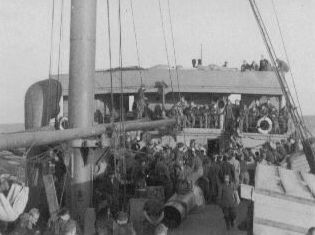 |
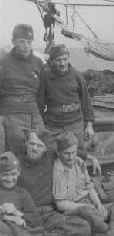 |
Images courtesy of
John Schaffa. Unknown ship at sea. |
2. Eyewitness
account from a civilian participant
From the autumn of 1939 until May 1940 a young
Czech woman, Marianne Adler, studied at the 'Universite
Libre de Bruxelles'. With the German invasion of Belgium she fled first to Paris, then
further south to stay with Czech friends in Beziers, the headquarters of the Czechoslovak
Division in France. Several weeks later the troops were evacuated, and she managed to get
a place on one of the ships too. The following extract from her personal memoirs and
images appear here by kind permission of her children: Dorrit, Martin and Peter Lowe.
| Then the day came, when the Czech army
was commanded to leave France for another location. French army camions were used to ferry
us to the seaport Sette, where a British ship was waiting to evacuate us. Everyone boarded
the ship apart from a bundle of Czech civilians, amongst them I, whom the Czechs refused
to take with them, because we were neither dependents of soldiers, nor embassy employees!
The French took pity on us and left us one of their camions, in which we could sleep
through the night, but we were too worried about what would become of us, to get much
sleep. In the morning the boat was about to set off, when the English captain became aware
of our plight. He declared that his orders were to pick up refugees, army or no army, and
so we entered the ship, although all the time being considered by the Czech burocrats as
the "illegals' getting the worst sleeping places and being the last ones in the
queues for food. The rope ladder on which we had climbed in, was drawn up, and we sailed
into the Mediterranean Sea, towards Gibraltar. When I say
"ship", you must not expect a nice steamer with cabins etc. It was in fact a
coal freighter, which had unloaded its coal in Marseilles and was ordered to pick us up.
It was correspondingly dirty, and we were just spread out on the floor of a big bunker
under the deck. What made it worse, there was a shortage of water, and we often had to
weigh up whether we should use our ration for drinking or washing. In Gibraltar the ship
did not land, but waited for three days in midwater for a larger ship to arrive and take
us over. The water shortage became more acute during that time, and we were relieved when
the ship at last arrived. It was a large troup ship, "Neuralia", which had just
come from India and had a mixed English and Indian crew. On it were loaded Czech and
Polish troops. This ship was a different proposition from our previous freighter. Very
spacious, cabins for one or two people, a large laundry room where at last we could wash
our clothes. The weather was warm and we spent a good part of the day on the deck, unless
there were readiness exercises. I spent much of my time playing games or telling stories
to the children on the boat, and it was then that I wrote a short story for them, which
was illustrated by a Polish pilot on board, and later printed in England.
We had no idea where the journey went. We had turned into the
Atlantic and went straight on, as if heading for America. It was not without danger, as
mines were laid in various places in the ocean, particularly near the coast. We tried to
guess: United States, Africa, I thought already of camping out in the open in a tropical
climate... Some of the few older people on ship were worried and depressed, one young
woman jumped into the sea with her baby in a fit of despair - a tragedy of which I only
learned later. But for young people like me, who had no ties, it was like a big adventure.
Eventually the news seeped through: Great Britain was to be our aim. The big roundabout
way we had taken, was mainly to avoid the sea mines. My heart sank when I heard this. It
was an anticlimax to my tropical phantasies, also I imagined England as a country where
the rain and fog never stop and the sun never comes out through the clouds. Our first
impressions of Liverpool, where we landed after having been three weeks at sea, were apt
to confirm the prejudice. The sky was dark and it poured with rain. Yet, this was to prove
one of the loveliest summers, to correct my ideas about England.
From Liverpool we were taken by train to our destinations. The civilians were
taken to London and accommodated in a large building, the "Empress Hall", Earls
Court, which is still an exhibition hall. Small camp beds were put up between the tiers of
the arena. Kind society ladies walked around amongst the refugees, handed out meals, made
conversation, distributed clothes, which had been collected for that purpose. These could
be tried on and I found it rather funny how some girls and young women, whose lives had
just about been saved, pranced about in front of the mirror and rejected anything that was
not to their taste. I was certainly glad to get anything at all. I forget to mention that
when on landing the storeroom of the boat was emptied of cases, mine and some others were
not to be found. This was already a much smaller one that the one I had taken along from
Belgium, as the non officers were warned that they would be allowed only minimum luggage.
Thus all that was left to me was a rucksack with some odd laundry and stockings. The lost
clothes did not worry me as much as some photos and letters, which I had carried with me
as souvenirs from Czechoslovakia.
In the Empress Hall the papers of everybody were checked and arrangements made
for our next steps, which in some cases took several days before it was one's turn. From
the start, officials we had met in England were civil and friendly, something we had not
experienced in Belgium or France. Nevertheless, I could not visualise that we would be set
completely free, I thought it would be a labour camp or similar. I was thus quite
incredulous when I was told that I could go my own way. My first abode was, however,
organised for me. Socalled "war refugees" could be either paid out L1 a week or
"billeted out" with a family, who received the money for our keep, and we
received 6d per week, for which we had to go to the Town Hall and get a stamp into a
little book. |
3. The War at Sea - part of
the official history
Click
here for part of the chapter from the official British history of the naval war
relating to the evacuations from France after the Dunkirk operation. Mentions are made of
Czech and Polish troops.
4. Links to other web
sources about the ships
More information about the Neuralia can be found on
the following web page:
http://www.merchantnavyofficers.com/Troopships.html
For more information about the British Navy ships mentioned as involved in the
evacuation, with outline plans and photographs, please see the following two web sites.
Site names and links to the main pages are given here, with links to the internal pages
relating to the specific ships shown under their names.
Royal Navy Ships of World War
2 http://website.lineone.net/~jimmer/WW2.html
WW2 Cruiser Operations http://www.world-war.co.uk/
H.M.S. VELOX
"V & W" Class destroyer completed in April 1918, converted for Long
Range Escort function.
Royal Navy Ships of World War 2 - "V & W" Class http://website.lineone.net/~jimmer/HTM-DD-old_VW.html
WW2 Cruiser Operations - "V & W" Class http://www.world-war.co.uk/destroyers/vw.html
H.M.S. KEPPEL
'Shakespeare' Class destroyer leader launched in April 1920.
Royal Navy Ships of World War 2 - "Shakespeare" Class http://website.lineone.net/~jimmer/HTM-DD-shakespeare.html
WW2 Cruiser Operations - "Shakespeare" Class http://www.world-war.co.uk/destroyers/shakespeare.html
H.M.S. ARETHUSA
"Arethusa" Class light cruiser commissioned in May 1935.
Royal Navy Ships of World War 2 - "Arethusa" Class http://website.lineone.net/~jimmer/HTM-CL-arethusa.html
WW2 Cruiser Operations - "Arethusa" Class http://www.world-war.co.uk/Arethusa/arethusa_class.htm
WW2 Cruiser Operations - H.M.S. Arethusa http://www.world-war.co.uk/Arethusa/arethusa.htm
WW2 Cruiser Operations - H.M.S. Arethusa torpedoed http://www.world-war.co.uk/web_arethusa.html
|



